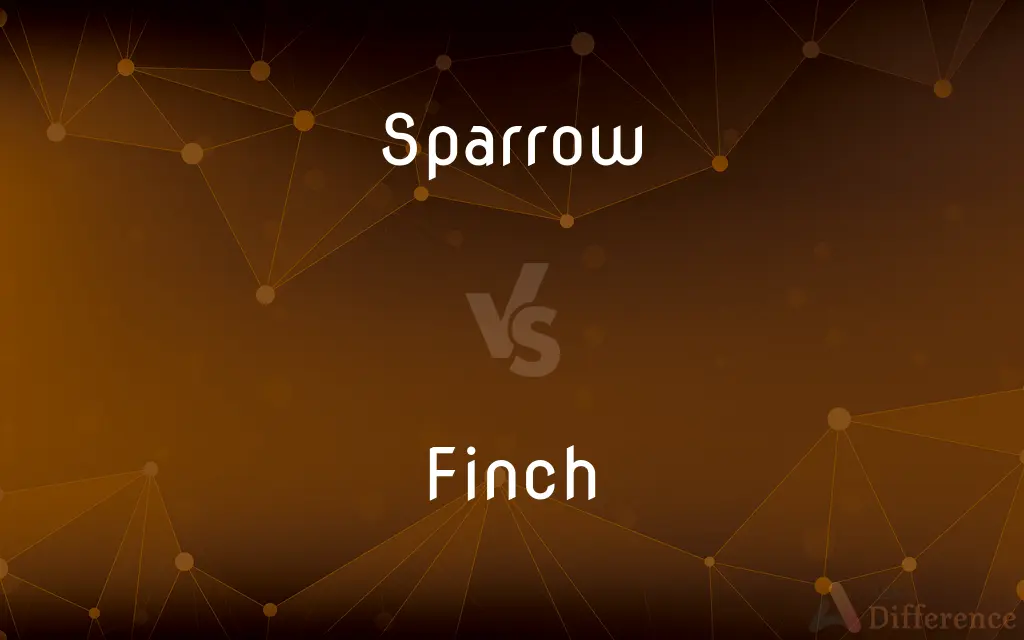Sparrow vs. Finch — What's the Difference?
By Tayyaba Rehman & Fiza Rafique — Updated on April 4, 2024
Sparrows are small, plump birds known for their adaptable nature, whereas finches are known for their diverse colors and strong beaks.

Difference Between Sparrow and Finch
Table of Contents
ADVERTISEMENT
Key Differences
Sparrows, belonging to the Passeridae family, are typically small, plump birds with brown and grey plumage, often found in urban and rural settings worldwide. They are known for their adaptability and are often associated with human habitats. Finches, on the other hand, belong to the Fringillidae family and are admired for their colorful plumage and strong, conical beaks, which are well-suited for their seed-based diets.
While sparrows are often more uniform in appearance, finches display a wider variety of colors and patterns, which can range from bright reds and yellows to more subdued hues. This diversity in coloration among finches is closely tied to their diet and habitat. Sparrows generally have a more consistent diet of seeds and insects, regardless of their environment, which contributes to their more uniform appearance.
The beak shape is another distinguishing feature between these two bird types. Sparrows have a smaller, less pronounced beak compared to finches, whose beaks are larger and more powerful, designed to crack open seeds. This difference in beak structure reflects their dietary preferences and feeding behavior.
Sparrows tend to be more social, often seen in large flocks, especially in urban areas where food resources are abundant. Finches, while also social, are more likely to be observed in smaller groups or pairs, particularly during the breeding season, and they often exhibit more territorial behavior.
Conservation status varies between the two, with some sparrow species being common and widespread, facing minimal risk, whereas certain finch species have encountered habitat loss and are considered vulnerable or endangered. This reflects the broader environmental challenges and the adaptability of these birds to changing conditions.
ADVERTISEMENT
Comparison Chart
Family
Passeridae
Fringillidae
Appearance
Small, plump, brown/grey plumage
Diverse colors, strong beaks
Beak Shape
Smaller, less pronounced
Larger, conical, suited for seeds
Social Behavior
Often found in large flocks
Smaller groups or pairs, more territorial
Conservation Status
Generally common and widespread
Varies, some species vulnerable or endangered
Compare with Definitions
Sparrow
Known for its brown and grey plumage.
Sparrows blend into their surroundings with their muted colors.
Finch
Some species are considered vulnerable.
The Gouldian finch is endangered due to habitat loss.
Sparrow
A small, adaptable bird often found in urban areas.
The house sparrow is common in cities around the world.
Finch
Has a diverse diet, primarily seeds.
Finches use their strong beaks to crack open seeds.
Sparrow
Social, forming large flocks.
A flock of sparrows descended on the bird feeder.
Finch
Found in smaller groups or pairs.
A pair of finches nested in the garden this spring.
Sparrow
Feeds on seeds and insects.
Sparrows can often be seen foraging for seeds on the ground.
Finch
A bird known for its colorful plumage and strong beak.
The goldfinch is admired for its vibrant yellow feathers.
Sparrow
Widespread and common in many habitats.
Sparrows are adaptable, thriving in both rural and urban settings.
Finch
Exhibits more territorial behavior.
Male finches may become territorial during the breeding season.
Sparrow
Any of various small birds of the family Emberizidae, having brownish or grayish plumage and found throughout the Americas, such as the song sparrow.
Finch
The true finches are small to medium-sized passerine birds in the family Fringillidae. Finches have stout conical bills adapted for eating seeds and nuts and often have colourful plumage.
Sparrow
Any of various birds of the family Passeridae, especially the house sparrow.
Finch
Any of various birds of the family Fringillidae, including the goldfinches, siskins, and canaries, having a short stout bill used for cracking seeds.
Sparrow
Any of various similar birds of other families, such as the Java sparrow.
Finch
Any of various birds of the families Cardinalidae and Emberizidae, including the sparrows, cardinals, and grosbeaks, having a similar bill.
Sparrow
The house sparrow, Passer domesticus; a small bird with a short bill, and brown, white and gray feathers.
Finch
Any Eurasian goldfinch (of species Carduelis carduelis. syn. Fringilla carduelis).
Sparrow
A member of the family Passeridae, comprising small Old World songbirds.
Finch
Any bird of the family Fringillidae, seed-eating passerine birds, native chiefly to the Northern Hemisphere and usually having a conical beak.
Sparrow
A member of the family Emberizidae, comprising small New World songbirds.
Finch
Any bird of other families of similar appearance to members of family Fringillidae.
Sparrow
Generically, any small, nondescript bird.
Finch
To hunt for finches, to go finching.
Sparrow
A quick-witted, lively person.
Cockney sparrow
Finch
A small singing bird of many genera and species, belonging to the family Fringillidæ.
Sparrow
One of many species of small singing birds of the family Fringilligæ, having conical bills, and feeding chiefly on seeds. Many sparrows are called also finches, and buntings. The common sparrow, or house sparrow, of Europe (Passer domesticus) is noted for its familiarity, its voracity, its attachment to its young, and its fecundity. See House sparrow, under House.
Finch
Any of numerous small songbirds with short stout bills adapted for crushing seeds
Sparrow
Any one of several small singing birds somewhat resembling the true sparrows in form or habits, as the European hedge sparrow. See under Hedge.
He that doth the ravens feed,Yea, providently caters for the sparrow,Be comfort to my age!
Sparrow
Any of several small dull-colored singing birds feeding on seeds or insects
Sparrow
Small brownish European songbird
Common Curiosities
What do sparrows eat?
Sparrows primarily feed on seeds and insects.
Can sparrows and finches be found in the same habitat?
Yes, sparrows and finches can share habitats, especially in regions where urban and natural environments overlap.
Are all finches colorful?
While many finches are colorful, the degree of coloration can vary significantly among different species.
Can finches adapt to urban environments like sparrows?
While finches can adapt to various environments, sparrows are particularly known for their ability to thrive in urban settings.
Do sparrows migrate?
Some sparrow species migrate, depending on their habitat and climatic conditions, while others are year-round residents.
What distinguishes a sparrow from a finch?
Sparrows and finches are differentiated by their family, appearance, beak shape, social behavior, and conservation status.
How do sparrows and finches behave differently?
Sparrows tend to form larger flocks and are highly adaptable, whereas finches are often found in smaller groups or pairs and can be more territorial.
Why are sparrows associated with human habitats?
Sparrows have successfully adapted to living in close proximity to humans, benefiting from the availability of food and nesting sites.
Why are some finch species endangered?
Habitat loss, environmental changes, and in some cases, pet trade, contribute to the endangerment of certain finch species.
Is the beak shape the only physical difference between sparrows and finches?
Beak shape is a primary difference, but overall size, plumage coloration, and pattern also distinguish them.
What is the significance of a finch's beak shape?
The shape of a finch's beak is adapted to its diet, particularly for cracking seeds, demonstrating a key aspect of evolution and adaptation.
How do sparrows and finches communicate?
Both sparrows and finches use a variety of chirps, calls, and songs to communicate, particularly during mating season and to mark territory.
Are finches good at singing?
Many finch species are known for their melodious and complex songs, which play a crucial role in courtship and territorial defense.
How do sparrows contribute to their ecosystem?
Sparrows help control insect populations and disperse seeds, playing a vital role in their ecosystems.
What efforts are being made to protect vulnerable finch species?
Conservation efforts include habitat preservation, legal protection, and breeding programs to support the populations of vulnerable and endangered finch species.
Share Your Discovery

Previous Comparison
Rainjacket vs. Raincoat
Next Comparison
Oba vs. SobaAuthor Spotlight
Written by
Tayyaba RehmanTayyaba Rehman is a distinguished writer, currently serving as a primary contributor to askdifference.com. As a researcher in semantics and etymology, Tayyaba's passion for the complexity of languages and their distinctions has found a perfect home on the platform. Tayyaba delves into the intricacies of language, distinguishing between commonly confused words and phrases, thereby providing clarity for readers worldwide.
Co-written by
Fiza RafiqueFiza Rafique is a skilled content writer at AskDifference.com, where she meticulously refines and enhances written pieces. Drawing from her vast editorial expertise, Fiza ensures clarity, accuracy, and precision in every article. Passionate about language, she continually seeks to elevate the quality of content for readers worldwide.














































